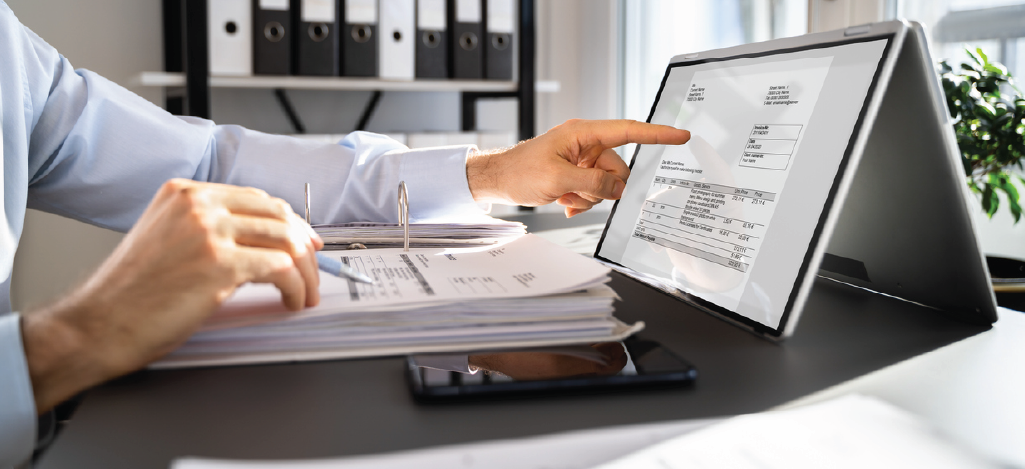Discover everything you need to know about billing applications in this comprehensive guide.
In today's fast-paced business world, organizations are increasingly relying on technology to streamline their operations. One aspect that plays a crucial role in any business is billing. Effective and efficient billing is essential for maintaining cash flow, tracking payments, and ensuring prompt invoicing. This is where a billing application comes into play. In this comprehensive guide, we will explore what billing applications are, their importance in business, key features, types, choosing the right one, and implementing it successfully. So, let's dive in!
Understanding Billing Applications

Definition and Function of a Billing Application
A billing application is a software solution designed to automate the billing process. It enables organizations to generate invoices, manage payments, track expenses, and handle tax and compliance matters efficiently. By automating these tasks, businesses can save time, reduce errors, and improve overall operational efficiency.
In today's fast-paced business environment, where time is of the essence, having a reliable and efficient billing application is crucial. These applications are designed to simplify the complex task of billing and make it more manageable for businesses of all sizes. With a billing application, organizations can easily create and send invoices, track payments, and manage their financial records in a systematic manner.
One of the key functions of a billing application is to generate invoices. These applications allow businesses to create professional-looking invoices with all the necessary details, such as the customer's information, products or services provided, and the total amount due. This not only saves time but also ensures accuracy in billing, reducing the risk of errors and disputes.
Billing applications also enable organizations to manage payments effectively. They provide features like payment reminders, online payment options, and integration with payment gateways, making it easier for customers to settle their bills. This not only improves cash flow but also enhances customer satisfaction by offering convenient payment methods.
Another important aspect of billing applications is expense tracking. These applications allow businesses to record and categorize their expenses, making it easier to monitor and control costs. By having a clear view of their expenses, organizations can make informed decisions and identify areas where they can cut costs or optimize spending.
Lastly, billing applications help businesses handle tax and compliance matters efficiently. They provide tools and features that simplify the process of calculating and reporting taxes, ensuring compliance with local tax regulations. This not only saves time but also reduces the risk of penalties or legal issues related to tax compliance.
Importance of a Billing Application
The importance of billing applications in business cannot be overstated. They provide a centralized platform for managing all billing-related activities, allowing organizations to streamline their financial processes. When businesses have accurate and timely billing, it positively impacts cash flow, enhances customer satisfaction, and improves overall financial performance.
Accurate and timely billing is crucial for maintaining a healthy cash flow. When businesses can generate invoices quickly and accurately, they can ensure that payments are received on time, reducing the risk of late payments or non-payment. This, in turn, helps businesses maintain a steady cash flow, which is essential for meeting financial obligations, such as paying suppliers, employees, and other expenses.
Billing applications play a significant role in enhancing customer satisfaction. When businesses can provide clear and accurate invoices, it instills trust and confidence in their customers. Additionally, features like online payment options and payment reminders make it easier for customers to settle their bills, resulting in a positive customer experience.
They also improve overall financial performance by providing insights into the organization's financial health. These applications generate reports and analytics that help businesses track their revenue, expenses, and profitability. By having a clear view of their financial performance, organizations can identify areas for improvement, make informed decisions, and optimize their financial strategies.
In conclusion, billing applications are essential tools for businesses of all sizes. They automate the billing process, saving time and reducing errors. They also provide a centralized platform for managing payments, tracking expenses, and handling tax and compliance matters. With accurate and timely billing, businesses can improve cash flow, enhance customer satisfaction, and improve overall financial performance.
Key Features of a Billing Application

Invoice Generation and Management
One of the primary functions of a billing application is invoice generation and management. With the application, businesses can easily create professional-looking invoices, customize them based on specific requirements, and maintain a record of all invoices sent to customers. This feature ensures efficient invoicing and helps track the payment status of each invoice.
Furthermore, the billing application provides businesses with the ability to add detailed descriptions and itemized lists to their invoices. This allows for clear communication of the products or services provided, making it easier for customers to understand and verify the charges. The application also enables the inclusion of company logos and branding elements, enhancing the professional appearance of the invoices.
In addition, the billing application offers the option to set up recurring invoices for regular customers. This feature automates the invoicing process, saving time and effort for businesses that have recurring billing cycles. It ensures that invoices are generated and sent out promptly, reducing the risk of delayed or missed payments.
Payment Processing and Tracking
Efficient payment processing and tracking are crucial for every business. A billing application allows organizations to offer multiple payment options to their customers, including credit card, online payment gateways, and traditional methods like checks and bank transfers. This flexibility provides convenience to customers, increasing the likelihood of prompt payments.
Moreover, the billing application integrates with payment gateways, enabling real-time payment processing. This means that businesses can receive payments instantly and securely, reducing the time and effort required for manual payment handling. The application also provides businesses with the ability to set up automatic payment reminders, reducing the chances of late payments and improving cash flow.
Additionally, the billing application tracks and reconciles payments, ensuring that all transactions are accurately recorded. This feature helps businesses identify any discrepancies or missing payments, allowing for timely resolution and preventing financial losses. The application also generates comprehensive payment reports, providing businesses with valuable insights into their cash flow and financial performance.
Tax and Compliance Management
Handling tax and compliance matters can be complex and time-consuming. A billing application simplifies this process by automating tax calculations, generating tax reports, and ensuring compliance with regulatory requirements. It saves businesses the hassle of manual calculations and reduces the risk of errors, penalties, and audits.
The billing application incorporates tax rules and rates based on the applicable jurisdiction, ensuring accurate tax calculations for each invoice. It automatically applies the appropriate taxes to the invoice total, eliminating the need for manual calculations and reducing the risk of errors. The application also generates detailed tax reports, providing businesses with a clear overview of their tax liabilities and facilitating easy tax filing.
Furthermore, the billing application keeps track of changes in tax regulations and updates its tax calculation algorithms accordingly. This ensures that businesses remain compliant with the latest tax laws and regulations, minimizing the risk of penalties or audits. The application also provides businesses with the ability to customize tax settings based on their specific requirements, accommodating different tax jurisdictions and exemptions.
In conclusion, a billing application offers a comprehensive set of features to streamline invoice generation and management, payment processing and tracking, as well as tax and compliance management. By leveraging these features, businesses can enhance their billing processes, improve cash flow, and ensure regulatory compliance.
Types of Billing Applications
Standalone Billing Applications
Standalone billing applications are designed solely for billing purposes. They provide a focused solution for businesses looking to streamline their billing process. Standalone applications offer features specific to billing, making them suitable for small to medium-sized organizations with straightforward billing needs.
Integrated a Billing Application
Integrated billing applications, on the other hand, are part of a larger business management system. These applications offer billing functionality alongside other modules like customer relationship management (CRM), accounting, and inventory management. Integrated applications are more suitable for larger organizations with complex billing requirements.
Choosing the Right Billing Application
Assessing Your Business Needs
Before selecting a billing application, it's vital to assess your business needs. Identify the specific requirements and challenges your organization faces in the billing process. Consider factors such as the volume of transactions, payment methods, tax regulations, and scalability needs. Understanding your needs will help you find an application that aligns with your business objectives.
Comparing Different Billing Applications
Once you know your business needs, compare different billing applications available in the market. Look for features that address your specific requirements, consider the user interface, and evaluate customer reviews and ratings. Narrow down your options to a few applications that best fit your criteria.
Considering Cost and Scalability
Cost and scalability are crucial factors to consider when choosing a billing application. Evaluate the pricing models offered by various vendors and determine whether they align with your budget and long-term goals. Additionally, consider the application's scalability to ensure it can accommodate your business growth and increasing billing demands.
Implementing a Billing Application

Planning and Preparation
Successful implementation of a billing application requires proper planning and preparation. Create a roadmap outlining the implementation process, including data migration, system integration, and employee training. Identify key stakeholders, set clear objectives, and allocate resources. This will help streamline the implementation process and minimize disruption to the organization.
Training and Support
After the application is implemented, provide comprehensive training to employees responsible for billing processes. Ensure they are familiar with the features and functionality of the application. Additionally, establish a support system with the vendor to address any issues or queries that may arise during day-to-day operations.
Monitoring and Evaluation
Once the billing application is up and running, regularly monitor its performance and evaluate its impact on organizational efficiency and customer satisfaction. Keep track of key metrics such as invoicing time, payment processing speed, and error rates. Periodically reassess your business needs and make necessary adjustments to maximize the benefits offered by the application.
In conclusion, a billing application is a crucial tool for modern businesses seeking to streamline their billing processes and improve financial management. By understanding what billing applications are, their key features, types, and considerations for choosing the right one, organizations can select an application that meets their unique requirements. Implementing a billing application requires careful planning, effective training, and continuous monitoring to ensure its successful integration into the organization's workflow. So, embrace the power of technology and unlock the benefits of a billing application for your business!
Going Forward with BillFlash
With BillFlash, practices can go further by optimizing their revenue cycle, efficiently collecting past-due A/R, and providing patients with a convenient and secure payment experience. With a user-friendly interface and industry experts available for all your billing, payments and collections needs, BillFlash is the perfect solution for small practices.

